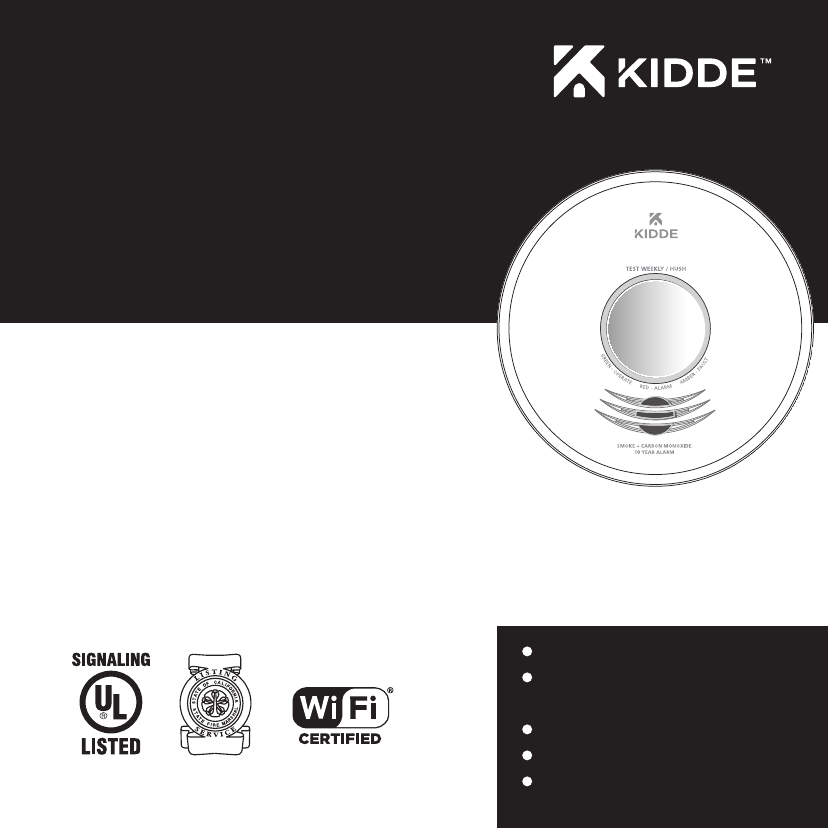
1
Kidde Smoke + Carbon Monoxide Alarm
User Guide
Combination Photoelectric Smoke
& Carbon Monoxide Alarm
with Voice, Hardwire Interconnect,
and Wi-Fi Compatibility
Model P4010ACSCO-WF
120V HARDWIRE
10-YEAR BATTERY BACKUP
(AC POWER REQUIRED)
HARDWIRE INTERCONNECT
Wi-Fi COMPATIBLE
VOICE ALARM
KIDDE Wi-Fi ALARM
P/N: 2592-7201-04 Rev B
Wi-Fi COMPATIBILITY:
This model requires a home Wi-Fi router
and internet to connect to a mobile device.
( Requires 802.11b/g/n (2.4GHz) Wi-Fi )
NOTE: Wi-Fi features do not function without AC power.

2
Thank You for Purchasing this Wi-Fi Alarm
Hardwired for 120VAC, this model features a non-replaceable, sealed-in battery backup. It also contains a
voice message system and SMART HUSH® Control to temporarily silence nuisance alarms. It is capable of
hardwire interconnect, and is Wi-Fi compatible with mobile devices.
For best Wi-Fi enrollment results, follow these steps:
1. Scan QR code shown in STEP 1 on the front of the Quick Start Guide. Install the Kidde app.
2.
Open the Kidde app. Create and login to your account. Tap “Add a device.” Select “Smoke + Carbon Monoxide
Alarm.”
Follow in-app steps.
3. Scan your unique QR code, shown in STEP 3 of the Quick Start Guide, or on back of your alarm. Setup and
connect alarm to the app. This will include the wiring and installation steps shown in sections 9, 10, and 11.
4. Complete setup by following in-app steps.
Teach children how to respond to the alarm and that they should never play with the unit. This alarm is a multi-criteria
device designed to detect both smoke and carbon monoxide from any source of combustion in a residential environ-
ment. It is not designed for use in a recreational vehicle (RV) or boat.
NOTE: Please thoroughly read this user guide and save the document for future reference and to pass on to
any subsequent owner. Images in this user guide are representative only. Actual product may vary slightly.
The National Fire Protection Association (NFPA) and the manufacturer recommend replacing this alarm ten years from
the date code on back of alarm.
WARNING: Mobile alert services are ancillary to the product and for informational purposes only. They are not
intended or suitable for life safety or critical purposes nor do these services take the place of third-party life safety
monitoring services. This product’s smartphone and tablet notifications require a stable Wi-Fi connection, and are only
as reliable as your home Wi-Fi network.
Date Code (on back): ___________________
Date of Purchase: ___________________
Where Purchased: ___________________
Date to Replace: ___________________
Product Support: 1-877-542-5471
Please write down the below information
and have this at hand when you call.

3
Contents
1. Smoke Alarm: What To Do When The Alarm Sounds . . . . . . . . 4
2. Carbon Monoxide Alarm: What To Do When The Alarm Sounds . . . . 5
3. Other Alarm Visual And Audible Indicators . . . . . . . . . . . 6
4. Troubleshooting Guide . . . . . . . . . . . . . . . . . 7
5. Introduction, Product Features & Specifications . . . . . . . . . 8
6. Limitations Of Smoke And Carbon Monoxide Alarms . . . . . . . . 9
7. Recommended Locations for Smoke And Carbon Monoxide Alarms . . . 11
8. Locations To Avoid . . . . . . . . . . . . . . . . . . 14
9. Wiring Instructions and Mounting Bracket Installation . . . . . . . 15
10 Kidde App Instructions . . . . . . . . . . . . . . . . . 19
11. Installation, Activation, and Wi-Fi Enrollment . . . . . . . . . . 20
11.1 Setting Up Wi-Fi Enrollment . . . . . . . . . . . . . . 20
11.2 Adding Another Device to an Existing Wi-Fi Alarm Network . . . . 21
11.3 Resetting a Device’s Wireless Settings . . . . . . . . . . . 22
11.4 Amazon Alexa and Google Assistant . . . . . . . . . . . 22
12. Operation And Testing . . . . . . . . . . . . . . . . . 23
13. Recognizing Nuisance Alarms . . . . . . . . . . . . . . 24
14. Battery Back Up . . . . . . . . . . . . . . . . . . . 25
15. Permanently Disable Alarm / Discharge Battery . . . . . . . . . 26
16. General Carbon Monoxide (CO) Information . . . . . . . . . . 27
17. Cleaning Your Alarm . . . . . . . . . . . . . . . . . 29
18. Good Safety Habits . . . . . . . . . . . . . . . . . . 30
19. Service And Warranty . . . . . . . . . . . . . . . . . 33
4
1. Smoke Alarm: What To Do When the Alarm Sounds
The smoke alarm pattern is three long beeps with voice “Fire!,” a 1.5 second pause, and three long beeps repeating.
The red LED blinks in time with the alarm pattern.
The smoke alarm takes precedence when both smoke and carbon monoxide are present.
• Alert small children in the home as well as anyone else that might have difficulty recognizing the importance of the
alarm sounding or that might have difficulty leaving the area without help.
• Leave immediately by your escape plan. Every second counts, so don’t waste time getting dressed or picking up
valuables.
• While leaving, don’t open any inside door without first feeling its surface. If hot, or if you see smoke seeping
through cracks, don’t open that door! Instead, use your alternate exit. If the inside of the door is cool, place your
shoulder against it, open it slightly and be ready to slam it shut if heat and smoke rush in.
• If the escape route requires you to go through smoke, stay close to the floor where the air is cleaner. Crawl if neces-
sary, and breathe shallowly through a cloth, wet if possible.
• Once outside, go to your selected meeting place and make sure everyone is there.
• Call the fire department from your cell phone outside, or from your neighbor’s home-not from yours!
• Don’t return to your home until the fire officials say that it is all right to do so.
NOTE: See Section RECOGNIZING NUISANCE ALARMS, for nuisance alarm situations.

5
2. Carbon Monoxide Alarm: What To Do When the Alarm Sounds
The carbon monoxide (CO) alarm pattern is four quick beeps with voice “Warning! Carbon
Monoxide” repeating every 5 seconds. The red LED blinks in time with the alarm pattern. On
DC power only, after 4 mins, the alarm pattern and voice will only occur every 60 sec.
WARNING: CARBON MONOXIDE ALARM ACTIVATION INDICATES THE PRESENCE OF
CARBON MONOXIDE (CO) AT HIGH CONCENTRATIONS WHICH CAN KILL YOU.
1) Operate the Test/Hush button. NOTE: Pressing the button on the initiating alarm unit (green
LED flashing every second) will silence the alarm notification, including all interconnected units.
If the unit goes into alarm mode again within six minutes, it is sensing high levels of CO which
can quickly become a dangerous situation.
2) Call your emergency services (Fire Department or 911). EMERGENCY PHONE #:___________
3) Immediately move to fresh air — outdoors or by an open door / window. Do a head count to
check that all persons are accounted for. Alert small children in the home as well as anyone else
that might have difficulty recognizing the importance of the alarm sounding or that might have
difficulty leaving the area without help. Do not reenter the premises or move away from the open
door/window until the emergency services responders have arrived, the premises have been aired
out, and your alarm remains in its normal condition.
4) After following steps 1-3, if the alarm reactivates within a 24 hour period, repeat steps 1-3 and
call a qualified appliance technician to investigate sources of CO from fuel burning equipment and
appliances, and to inspect for proper operation of equipment.
If problems are identified during this inspection, have the equipment serviced immediately.
Note any combustion equipment not inspected by the technician and consult the manufactur-
er’s instructions, or contact the manufacturer directly for more information about CO safety and
the equipment. Make sure that motor vehicles are not, or have not been, operating in a garage
attached or adjacent to the residence. Never restart the source of a CO problem until it has been
corrected. Never ignore the sound of the alarm!
NOTE: See Section RECOGNIZING NUISANCE ALARMS, for nuisance alarm situations.

6
3. Other Alarm Visual and Audible Indicators
(1) Requires additional devices and/or permissions in app to enable these features.
Operational Mode Visual Indications Audible Indications Action/Note:
Normal (standby)
AC power: Green LED on continuously during
light conditions, or blink every 60 sec during dark
conditions.
DC power: Green LED blink approx every 60 sec.
Test (button press when no
alarm condition is present,
and the device is online and
connected to Wi-Fi, or if the
device was never connected
to Wi-Fi, or if the device was
reset and removed from a Wi-Fi
network.)
• 4 patterns of Red/Amber/Green.
• Test: Red LED blinks in time with alarm
pattern.
• Green LED fade on/off at test complete
• Button press sound
• Voice: "Testing, this is very loud.
Press now to cancel test. 5, 4, 3, 2, 1."
• 3 long beeps, Voice "Fire!",
3 long beeps, 4 quick beeps, Voice
"Warning, Carbon Monoxide," 4
quick beeps, Voice "Test Complete,"
Power on/reset sound.
• Voice "Test Canceled" if button
pushed before test sequence begins.
Perform button press once a week
to verify proper alarm operation
* Push/release button before the
countdown ends to cancel test.
Test (button press when no
alarm condition is present, and
the device is disconnected from
Wi-Fi)
None Voice "Not Connected" after button
push.
.
Take appropriate action to restore
Wi-Fi connection.
Smoke or CO Alarm Memory
(unit has experienced a smoke
or CO alarm event within the
last hour)
Red and Amber LED alternate on 1 sec,
every 10 sec.
After button push, voice "Smoke
previously detected" or "Carbon
Monoxide previously detected" only on
the initiating alarm unit.
Push button to clear Alarm
Memory. NOTE: standard test
sequence will follow. (Push/release
button again to cancel test).
Smoke Alarm Hush Mode,
(SMART HUSH®
CONTROL)
Red LED blinks every 2 sec. After button push, voice "Hush Mode
Activated." Smoke alarm pattern
stops.
(If there is too much smoke to allow
Hush: Voice "Too Much Smoke, Alarm
cannot be Hushed" Smoke alarm
pattern continues.)
This feature is to be used only
when a known alarm condition,
such as smoke from cooking,
activates the alarm.
CO alarm reset None After button push: CO alarm pattern
stops.
Unit is confirming if CO is present
or if it experienced a nuisance
situation. Re-alarm means danger.
Move to fresh air and call 911.
Smoke Alarm Hush Mode
Canceled
None Voice "Hush Mode Canceled." When smoke levels drop below the
alarm threshold, the voice message
will occur .
Initiating Alarm,
(Multiple alarms in an
interconnected system)
Green LED blinks once per sec indicating
that this is the unit initiating the alarm in an
interconnected, multiple alarm, system.
Unit in either Smoke or CO alarm
mode.
During alarm, the initiating alarm
red blink will be interrupted by a
green blink.
Weather & Intruder Alert
(1)
Red LED flashes every sec. One long beep, 5 sec pause, Voice:
“Weather emergency in vicinity” OR
one long beep every other sec, voice
every 10 sec “Intruder detected.”
Take appropriate precautions.

7
4. Troubleshooting Guide
If you are experiencing a problem with your alarm, or a fault, and are unsure of the next action, please contact product
support at 1-877-542-5471 before discharging the battery. You may also write us at: Kidde, 1016 Corporate Park Drive,
Mebane, NC 27302, or visit our internet address at www.kidde.com.
Trouble Condition Visual Indications Audible Indications Action:
False Low Battery
(AC power
connected before
backup battery
activated)
Amber
LED
blinks
every
5
seconds
Chirp every 60 sec, with voice
"Activate Battery."
* Rotate unit fully onto mounting bracket to activate
battery.
Low Battery Chirp every 60 sec, voice every 30
sec: “Replace alarm.”
Voice stops after 5 mins.
* Remove, discharge, dispose unit, and replace as soon
as possible.
Fault Mode Chirp every 30 sec.
Voice every 30 sec: “Error, see
trouble shooting guide”
After 5 mins: no voice message
* See Cleaning Your Alarm section.
*
Push button once to attempt to reset the unit.
* Red LED will blink out an error code (number of
blinks) when button is pushed. Report the number of
blinks to customer service if needed.
* If error persists, or if customer service directs, remove,
discharge, dispose unit, and replace as soon as
possible.
End of Unit Life Amber LED blinks
twice every
5 seconds.
Double chirp every 30 sec. First 5
mins: Voice every 30 sec: “Replace
alarm, press button to temporarily
silence.” Voice stops after 5 mins. Voice
“Temporarily Silenced” after button
push (first 7 days only). After 7 days,
chirps continue, with voice “Replace
Alarm” every 30 sec for 5 mins.
*
Push button once to silence for 24 hrs. (Push button
again to clear Hush and perform a test.)
Note: 7 days after End of Unit Life begins, the
notifications cannot be silenced.
* Remove, discharge, dispose unit, and replace as soon
as possible.
Network Error Amber LED blinks
every 5 seconds.
Chime every 30 secs. Voice every 30
sec: “Connection lost, press button to
temporarily silence.” After 5 min: no
voice messages. Voice “Temporarily
Silenced” after button push.
* Push button to temporarily silence for 24 hrs. (Push
button again to clear Hush and perform a test.)
* Call customer service.
* If error continues, remove, discharge, dispose unit,
and replace as soon as possible.
Loss of Wi-Fi
Connection
None Voice “Not Connected” after button
push.
Test sequence does not occur in this
mode upon button push.
*
The unit will attempt to re-connect on its own. After 10
consecutive mins of lost connection, you will receive a
notification of “Contact Lost” in your mobile App.
NOTE: Normal test button functionality will be
unavailable until Wi-Fi connection is restored.
* Contact customer service. If error persists, or if
customer service directs, remove, discharge, dispose
unit, and replace as soon as possible.
Stuck Button None Chirp every 4 sec. * Push button to dislodge it from being stuck. If button
cannot be unstuck, remove alarm, discharge, dispose
unit, and replace as soon
as possible.
8
5. Introduction, Product Features and Specifications
Introduction
This alarm detects products of combustion using photoelectric technology and carbon monoxide using an electrochem-
ical cell. Many times throughout this User Guide, we will refer to Carbon Monoxide as “CO.” Ten (10) years after the
unit was activated, this unit will automatically alert you that it is time to replace the unit. This is called “End of Unit Life”
mode. See Troubleshooting Guide. To help identify the date to replace the unit, a label has been affixed to the side of
the alarm. Write the “Install date” in the space provided, and then write in the “Replace by” date (10 years from initial
power up) in permanent marker on the label prior to installing the unit. NOTE: AC power must be connected to
obtain the full 10 year battery and unit life. Two labels have been provided that have important information on what
to do in case of a CO alarm. Place one label at eye level on a wall near the alarm after it is mounted, and one near a fresh
air source such as a door or window.
Product Features and Specifications:
• Temperature: Operating Range: 40°F (4.4°C) to 100°F (37.8°C)
• Humidity: Operating range: 10-95% RH non-condensing
• Audible Alarm: 85+ dB at 10’ 3.0 to 3.5 KHz pulsing alarm, with voice messages
“Fire!” and/or “Warning! Carbon Monoxide”
• Smoke Sensor: Photoelectric
• CO Sensor: Electrochemical
• Voice message system
• Smoke Alarm SMART HUSH® Control
• Ambient Light Sensing
• Powered by 120VAC (60 Hz, 53 mA max) wire-in connector with sealed lithium battery backup
• Hardwire Interconnect
• Wi-Fi Compatible to Mobile Device ( Requires 802.11b/g/n (2.4GHz) Wi-Fi )
• One large, user-friendly button

9
6. Limitations of Smoke and Carbon Monoxide Alarms
WARNING: PLEASE READ CAREFULLY AND THOROUGHLY
• Life safety from fire in residential occupancies is based primarily on early notification to occupants of the need to
escape, followed by the appropriate egress actions by those occupants.
• Fire warning systems for dwelling units are capable of protecting about half of the occupants in potentially fatal
fires. A smoke alarm may not be effective in some situations, such as during incendiary fires where the fire grows so
rapidly that an occupant’s egress is blocked even with properly located smoke alarms, or when victims are intimate
with the fire (for example, when a person’s clothes catch fire while cooking), too old or young, or physically or
mentally impaired such that they cannot escape even when warned early enough that escape should be possible. For
these people, additional strategies such as protection-in-place or assisted escape or rescue are necessary. *
• Leading authorities recommend that both ionization and photoelectric smoke alarms be installed to help insure max-
imum detection of the various types of fires that can occur within the home. Ionization sensing alarms may detect
invisible fire particles (associated with fast flaming fires) sooner than photoelectric alarms. Photoelectric sensing
alarms may detect visible fire particles (associated with slow smoldering fires) sooner than ionization alarms.
• A battery powered alarm must have a battery of the specified type, in good condition and installed properly (this
model has a sealed backup battery).
• Smoke alarms must be tested regularly to make sure the battery and the alarm circuits are in good operating condition.
• Smoke alarms cannot provide an alarm if smoke does not reach the alarm. Therefore, smoke alarms may not sense
fires starting in chimneys, within walls, on roofs, on the other side of a closed door or on a different floor.
• If the alarm is located outside the bedroom or on a different floor, it may not wake up a sound sleeper.
• The use of alcohol or drugs may also impair one’s ability to hear the smoke alarm. For optimal detection, a smoke
alarm should be installed in each sleeping area on every level of a home.
• There are situations where a smoke alarm may not be effective to protect against fire as stated in the NFPA Standard 72.
For instance:
a) smoking in bed
b) leaving children home alone
c) cleaning with flammable liquids, such as gasoline
This alarm is not intended to alert hearing impaired individuals.
* Reference National Fire Protection Association (NFPA) standard 72

10
WARNING: PLEASE READ CAREFULLY AND THOROUGHLY
• IMPORTANT: This alarm is designed to detect carbon monoxide gas from ANY source of combustion. It is NOT
designed to detect any other gas.
CAUTION: This alarm will only indicate the presence of carbon monoxide gas at the sensor. Carbon
monoxide gas may be present in other areas. Never restart the source of a CO problem until it has been fixed.
NEVER IGNORE THE ALARM!
WARNING: THIS PRODUCT IS INTENDED FOR USE IN ORDINARY INDOOR LOCATIONS OF FAMILY
LIVING UNITS. IT IS NOT DESIGNED TO MEASURE COMPLIANCE WITH OCCUPATIONAL SAFETY AND
HEALTH ADMINISTRATION (OSHA) COMMERCIAL OR INDUSTRIAL STANDARDS. IT IS NOT SUITABLE FOR
INSTALLATION IN HAZARDOUS LOCATIONS AS DEFINED IN THE NATIONAL ELECTRIC CODE. IT IS NOT
DESIGNED FOR USE IN A RECREATIONAL VEHICLE (RV) OR BOAT.
• The installation of this device should not be used as a substitute for proper installation, use, and maintenance of fuel
burning appliances, including appropriate ventilation and exhaust systems.
• This alarm does not prevent CO from occurring, nor can it solve any existing CO problem.
WARNING: THIS DEVICE IS DESIGNED TO PROTECT INDIVIDUALS FROM ACUTE EFFECTS OF
CARBON MONOXIDE EXPOSURE. IT WILL NOT FULLY SAFEGUARD INDIVIDUALS WITH SPECIFIC MEDICAL
CONDITIONS. IF IN DOUBT, CONSULT A MEDICAL PRACTITIONER. INDIVIDUALS WITH MEDICAL
PROBLEMS MAY CONSIDER USING WARNING DEVICES WHICH PROVIDE AUDIBLE AND VISUAL SIGNALS
FOR CARBON MONOXIDE CONCENTRATIONS UNDER 30 PPM. *
• This alarm has not been investigated for carbon monoxide detection below 70 PPM.
• This combination smoke and carbon monoxide alarm requires a continuous supply of electrical power – it will not
work without power.
* Reference Underwriters Laboratories (UL) standard 2034
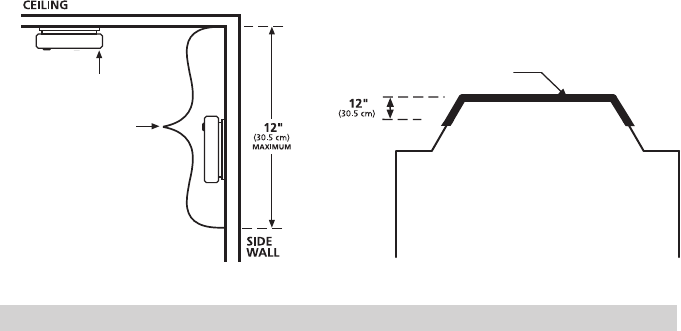
11
7.
Recommended Locations For Smoke And Carbon Monoxide Alarms
• Locate smoke alarms in all sleeping areas. Try to monitor the exit path as the bedrooms are usually farthest from the
exit. If more than one sleeping area exists, locate additional alarms in each sleeping area.
• Locate additional alarms in stairways, because stairways act like chimneys for smoke and heat.
• Locate at least one alarm on every floor level.
• Locate an alarm in every bedroom.
• Locate an alarm in every room where electrical appliances are operated (i.e. portable heaters or humidifiers).
• Locate an alarm in every room where someone sleeps with the door closed. The closed door may prevent an alarm
not located in that room from waking the sleeper.
• Smoke, heat, and combustion products rise to the ceiling and spread horizontally. Mounting the smoke alarm on the
ceiling in the center of the room places it closest to all points in the room. Ceiling mounting is preferred in ordinary
residential construction.
ACCEPTABLE
TOP OF ALARM
ACCEPTABLE HERE
Note: measurements shown
are to the closest edge
of the alarm.
ANYWHERE ALONG
THIS BOLD SURFACE
Locations permitted for smoke
alarms and smoke detectors
on tray-shaped ceilings.
Not within 6 feet of appliances
Figure 7-A
ANYWHERE ALONG
THIS BOLD SURFACE
Locations permitted for smoke
alarms and smoke detectors
on tray-shaped ceilings.

12
ACCEPTABLE
TOP OF ALARM
ACCEPTABLE HERE
Note: measurements shown
are to the closest edge
of the alarm.
ANYWHERE ALONG
THIS BOLD SURFACE
Locations permitted for smoke
alarms and smoke detectors
on tray-shaped ceilings.
Not within 6 feet of appliances
ACCEPTABLE
TOP OF ALARM
ACCEPTABLE HERE
Note: measurements shown
are to the closest edge
of the alarm.
ANYWHERE ALONG
THIS BOLD SURFACE
Locations permitted for smoke
alarms and smoke detectors
on tray-shaped ceilings.
Not within 6 feet of appliances
ACCEPTABLE
TOP OF ALARM
ACCEPTABLE HERE
Note: measurements shown
are to the closest edge
of the alarm.
ANYWHERE ALONG
THIS BOLD SURFACE
Locations permitted for smoke
alarms and smoke detectors
on tray-shaped ceilings.
Not within 6 feet of appliances
ACCEPTABLE
TOP OF ALARM
ACCEPTABLE HERE
Note: measurements shown
are to the closest edge
of the alarm.
ANYWHERE ALONG
THIS BOLD SURFACE
Locations permitted for smoke
alarms and smoke detectors
on tray-shaped ceilings.
Not within 6 feet of appliances
NFPA 72 states: “Smoke alarms in rooms with ceiling slopes greater than 1 ft in 8 ft (0.3m in 2.4 m)
horizontally shall be located on the high side of the room.” NFPA 72 states: “A row of detectors shall be
spaced and located within 3 ft (0.9m) of the peak of the ceiling measured horizontally.”
Figure 7-B Figure 7-C

13
• For mobile home installation, select locations carefully to avoid thermal barriers that may form at the ceiling. For
more details, see MOBILE HOME INSTALLATION section.
• When mounting the alarm on the wall, use an inside wall with the top edge of the alarm at a maximum of 12” (30.5
cm) below the ceiling.
• Put smoke alarms at both ends of a bedroom hallway or large room if the hallway or room is more than 30 feet (9.1
m) long.
• Install Smoke Alarms on sloped, peaked or cathedral ceilings at or within 3ft (0.9m) of the highest point (measured
horizontally).
• Industry experts recommend a CO alarm be installed on each level of the home-ideally on any level with fuel burning
appliances and outside of sleeping areas.
This equipment should be installed in accordance with the National Fire Protection Association’s 72 (National
Fire Protection Association, Batterymarch Park, Quincy, MA 02269).
Mobile Home Installation
Modern mobile homes have been designed and built to be energy efficient. Install smoke alarms as recommended
above. In older mobile homes that are not well insulated compared to present standards, extreme heat or cold can be
transferred from the outside to the inside through poorly insulated walls and roof. This may create a thermal barrier
which can prevent the smoke from reaching an alarm mounted on the ceiling. In such units, install the smoke alarm on
an inside wall with the top edge of the alarm a maximum of 12” (30.5 cm) below the ceiling.
If you are not sure about the insulation in your mobile home, or if you notice that the outer walls and ceiling are either
hot or cold compared to the room air temperature, install the alarm on an inside wall. NFPA 72 (National Fire Protection
Association) requires smoke alarms be installed in each sleeping area.
WARNING: TEST YOUR ALARM OPERATION AFTER MOBILE HOME HAS BEEN IN STORAGE OR UNOC-
CUPIED, AND AT LEAST ONCE A WEEK DURING USE.
14
8. Locations to Avoid
(See Figures 7-A, 7-B, & 7-C for recommended locations)
• In the garage. Products of combustion are present when you start your automobile.
• Normal cooking may cause nuisance alarms. If a kitchen alarm is desired, it should have an alarm silence feature or
be a photoelectric type.
• Do not install within 6 ft. of heating or cooking appliances.
• Less than 4” (10cm) from the peak of an “A” frame type ceiling.
• In an area where the temperature may fall below 40ºF or rise above 100ºF, such as garages and unfinished attics.
• In dusty areas. Dust particles may cause nuisance alarms or a failure to alarm.
• In very humid areas (above 95% RH, non-condensing), as moisture or steam can cause nuisance alarms..
• In insect-infested areas.
• Smoke alarms should not be installed within 3 ft (0.9m) of the door to a bathroom containing a tub or shower,
forced air supply ducts used for heating or cooling, ceiling or whole house ventilating fans, or other high air flow
areas.
• Near lights. Electronic “noise” generated by the electronics may cause nuisance alarms.
• Do not install near vents, flues or chimneys.
• Do not install near fans, doors, windows or areas directly exposed to the weather.

15
9. Wiring Instructions and Mounting Bracket Installation
For best Wi-Fi enrollment results, follow these steps:
1. Scan QR code shown in STEP 1 on the front of the Quick Start Guide. Install the Kidde app.
2.
Open the Kidde app. Create and login to your account. Tap “Add a device.” Select “Smoke + Carbon Monoxide
Alarm.” Follow in-app steps.
3. Scan your unique QR code, shown in STEP 3 of the Quick Start Guide, or on back of your alarm. Setup and
connect alarm to the app. This will include the wiring and installation steps shown in sections 9, 10, and 11.
4. Complete setup by following in-app steps.
Wiring Requirements
• This alarm should be installed on a UL Listed or recognized junction box. All connections should be made by a
qualified electrician and all wiring used shall be in accordance with articles 210 and 300.3(B) of the U.S. National
Electrical Code ANSI/NFPA 70, NFPA 72 and/or any other codes having jurisdiction in your area. The multiple station
interconnect wiring to the alarms must be run in the same raceway or cable as the AC power wiring. In addition, the
resistance of the interconnect wiring shall be a maximum of 10 ohms.
• The appropriate power source is 120 Volt AC Single Phase, supplied from a non-switchable circuit.
• Smoke alarms are not to be used with detector guards unless the combination (alarm and detector guard) has been
evaluated and found suitable for that purpose.
• Kidde alarms are not designed, agency tested or certified for recessed mounting and should not be installed in this
manner. Recessed mounting impedes smoke entry into the smoke chamber, which may prevent the alarm from
sounding in a timely manner. This could endanger the lives of occupants in the residence. Kidde alarms are de-
signed, tested and certified for wall (if applicable) and ceiling surface mount only. Without agency research, we have
no fire test data to support that alarms will perform as required when installed in a recessed manner. Accordingly,
we do not recommend, approve or advise mounting Kidde alarms in recessed configurations.
WARNING: THE ALARM CANNOT BE OPERATED FROM POWER DERIVED FROM A SQUARE WAVE,
MODIFIED SQUARE WAVE OR MODIFIED SINE WAVE, INVERTER. THESE TYPES OF INVERTERS ARE SOME-
TIMES USED TO SUPPLY POWER TO THE STRUCTURE IN OFF GRID INSTALLATIONS, SUCH AS SOLAR OR
WIND DERIVED POWER SOURCES. THESE POWER SOURCES PRODUCE HIGH PEAK VOLTAGES THAT WILL
DAMAGE THE ALARM.
Wiring Instructions for AC Quick Connect Harness
CAUTION: Turn off the main power to the circuit before wiring the AC Quick Connect Harness.
• For alarms that are used as single station, DO NOT CONNECT THE RED WIRE TO ANYTHING. Leave the red wire
insulating cap in place to make certain that the red wire cannot contact any metal parts or the electrical box.
NOTE: Single station alarms (including this Wi-Fi model, if used as a single station alarm) CANNOT send or receive smoke
or CO alarm signals to other hardwire interconnect alarms in your home. If this model is used as a single station alarm, it
will send notifications ONLY to your mobile device (after the Wi-Fi alarm is registered with the Kidde app).
• When alarms are hardwire interconnected, all interconnected units must be powered from a single circuit.
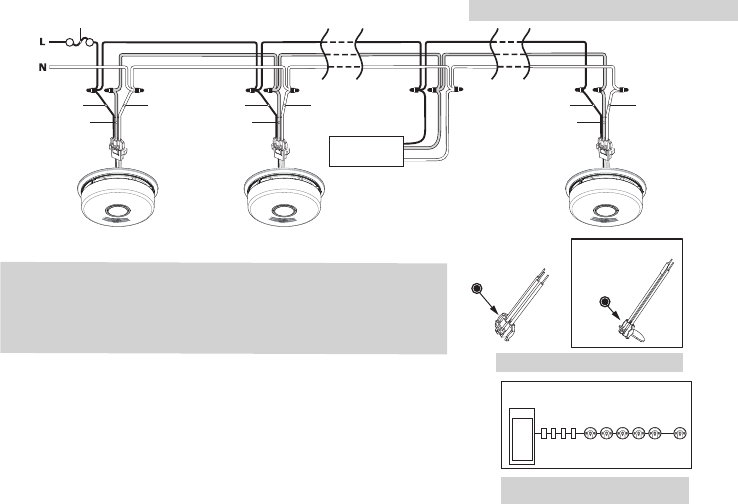
16
• A maximum of 24 Kidde Safety devices may be interconnected in a multiple station arrangement. The intercon-
nect system should not exceed the NFPA interconnect limit of 12 smoke alarms and/or 18 alarms total (smoke, CO,
Smoke/ CO Combination, heat, etc.). With 18 alarms interconnected, it is still possible to interconnect up to a total of
6 remote signaling devices and / or relay modules.
• The maximum wire run distance between the first and last unit in an interconnected system is 1000 feet.
• Figure 9-A illustrates interconnection wiring. Improper connection will result in damage to the alarm, failure to
operate, or a shock hazard.
• Make certain alarms are wired to a continuous (non-switched) power line.
NOTE: Use standard UL Listed household wire (as required by local codes) available at all electrical supply
stores and most hardware stores.
• For best results to minimize nuisance alarms, interconnected alarms should be on a dedicated line. If not on a dedi-
cated line, it is suggested that the smoke alarms share a lighting load circuit that does not have a dimmer associated
with it. If receptacles must be placed on the same line it is suggested that they be placed ahead of the smoke alarms
(see Figure 9-C). This will prevent large voltage drops from occurring between the first and last alarm in the circuit.
Figure 9-A, Interconnect Wiring Diagram
Existing Kidde
AC Connector
(either connector
can be used for
this model)
AC connector
shipped with
product
Wires on alarm harness: Connected to:
Black: Hot side of AC line
White: Neutral side of AC line
Red: Interconnect lines (red wires) of other
units in the multiple station set-up
Figure 9-C
Figure 9-B
Service
Panel
Receptacles Interconnected alarms
Wiring practice that has had good results
in preventing nuisance alarms
Additional
Alarm
WHITEWHITE BLACK
RED
Additional
Alarm
WHITE
BLACK
RED
FUSE OR CIRCUIT BREAKER
RED
BLACK
Kidde Relay Module
SM120X, CO120X
or both
Optional
Accessory
First
Alarm
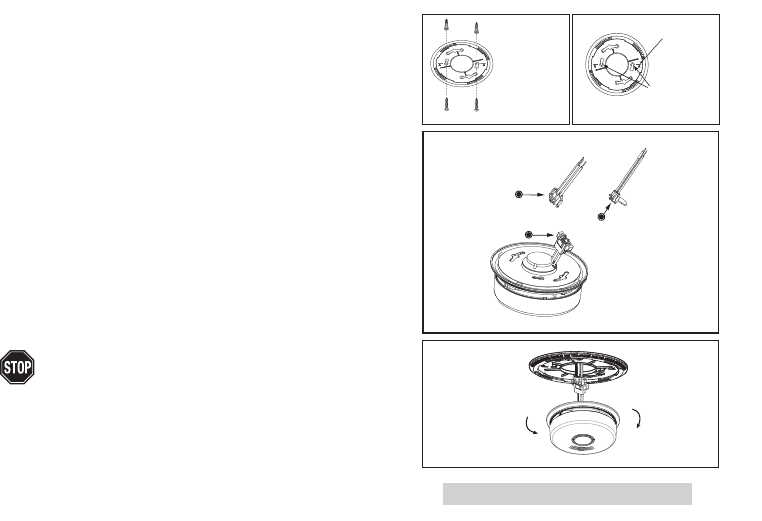
17
NOTE: AC power should be turned off at this stage.
• After selecting the proper location for your Alarm, and wiring
the AC QUICK CONNECT harness as described in the WIRING
INSTRUCTIONS, attach the mounting bracket to the electrical
box. To ensure aesthetic alignment of the alarm with the hall-
way, or wall, the “A” line on the mounting bracket should be
parallel with the hallway when ceiling mounted, or horizontal
when wall mounted (See Figure 9-D).
• Pull the AC QUICK CONNECTOR through the center hole in
the mounting bracket and secure the bracket, making sure
that the mounting screws are positioned in the small ends of
the keyholes before tightening the screws.
• Proceed to Section 10 for Kidde App Instructions.
If you are installing for Wi-Fi functionality, and have not yet
downloaded the Kidde App, do not connect your Wi-Fi unit
to the AC quick connect harness or mounting bracket yet. See
Section 10 for instructions on downloading the Kidde App. If you
are not using the Wi-Fi function, then proceed with the following
three steps.
• Plug the AC QUICK CONNECTOR into the wiring harness
attached to the unit, making sure that the locks on the connector
snap into place. Then push the excess wire back into the electrical
box through the hole in the center of the mounting bracket.
• Install the alarm fully on the mounting bracket by rotating the alarm in a clockwise direction. NOTE: The alarm will
mount to the bracket in 4 positions (every 90 degrees). NOTE: Installing the alarm on the mounting bracket will
automatically activate the battery backup.
• Turn on the AC power. The green AC Power On Indicator should be lit when the alarm is operating from AC power.
NOTE: Wi-Fi units will emit a series of LED blinks, tones, and voices as the unit(s) search for a Wi-Fi alarm
network. If you are intending to use Wi-Fi units without the Wi-Fi function, ignore these notifications, and
the Wi-Fi function will turn off in about 15 minutes, or you can push/hold the button until you hear two
beeps (about four seconds), to exit Wi-Fi enrollment mode. You can turn the Wi-Fi function on again at a later
date if desired. See Section 11.3 .
When mounting
in a hallway,
the "A" line should
be parallel with the
hallway. When wall
mounting, the "A"
line should be
horizontal.
Alignment Marks
(”A” Line) on
Mounting
Bracket
Mark and drill
two 3/16" (5mm)
holes for wall
anchors
A
Remove
Install
Existing Kidde
AC Connector
(either connector
can be used for
this model)
AC connector
shipped with
product
AC connector
Figure 9-D

18
NOTE: Attaching AC power first, without rotating the alarm onto the mounting bracket, will result in a false
low battery trouble condition chirp (see Troubleshooting Guide). You need to activate the battery to elimi-
nate the low battery trouble condition chirps. Attach unit to mounting bracket very soon after applying AC
power to avoid false low battery notification.
NOTE: The battery activation is a one-time feature. After activation, the battery cannot be turned off, and
can only be discharged at the end of unit life. If the alarm is removed from the mounting plate, the backup
battery will remain active. See Permanently Disable Alarm / Discharge Battery section.
The alarm is now activated! After installation / activation, test your alarm as described in Operation and Testing
section.
WARNING: FAILURE TO PROPERLY INSTALL AND ACTIVATE THIS ALARM WILL PREVENT PROPER
OPERATION OF THIS ALARM AND WILL PREVENT ITS RESPONSE TO FIRE HAZARDS.
Interconnect Capability
This model has AC hardwire interconnect capability. When one hardwire interconnect unit sounds an alarm, all other
compatible hardwire interconnected units will also alarm. NOTE: AC wiring must be completed properly and the AC
quick connector must be attached to the unit for the hardwire interconnect function to work.
AC Hardwire Interconnect Model Compatibility
• The following models can be interconnected using the standard AC wiring interconnect: i12020,
i12020A, i12040, i12040A, i12060, i12060A, i12080, i12080A, i4618, i4618A, i4618AC, KN-SMFM-I,
RF-SM-ACDC, PE120, P12040, Pi2000, Pi2010, KN-COSM-I, KN-COSM-IB, KN-COSM-IBA, KN-COPE-I,
KN-COPE-IC, KN-COB-IC, KN-COP-IC, SL177i, SLED177i, HD135F, SM120X, CO120X, i12010S,
i12010SCO, P4010ACSCO, P4010ACSCO-W, P4010LACS-W, P4010ACS, P4010ACS-W, P4010ACLEDS,
P4010ACLEDS-2, P4010ACLEDSCO, P4010ACLEDSCO-2, 3050-VAS10-A, 3050-VASC10-A,
P4010ACSCO-WF.
NOTE: Although this Wi-Fi model will hardwire interconnect with the models listed above, the Wi-Fi alarm will
ONLY transmit smoke and CO alarm signals from these alarms to your mobile device (after the Wi-Fi alarm is
registered with the Kidde app). Other status notifications from non Wi-Fi alarms, such as low battery, end of
unit life, or a fault condition, will NOT be transmitted to your mobile device through the Wi-Fi alarm.

19
10. Kidde App Features and Instructions
For best Wi-Fi enrollment results, follow these steps:
1. Scan QR code shown in STEP 1 on the front of the Quick Start Guide. Install the Kidde app.
2. Open the Kidde app. Create and login to your account. Tap “Add a device.” Select “Smoke + Carbon Monoxide
Alarm.” Follow in-app steps.
3. Scan your unique QR code, shown in STEP 3 of the Quick Start Guide, or on back of your alarm. Setup and
connect alarm to the app. This will include the wiring and installation steps shown in sections 9, 10, and 11.
4. Complete setup by following in-app steps.
Your Kidde app is user friendly and allows helpful features such as:
• Get alarm notifications if smoke or carbon monoxide is detected in your home.
• Receive notifications when a device needs to be replaced.
• Simplify setup - Just scan the QR code on the back of the product. No additional hub is needed.
• Notify friends and family of potential danger.
• Test the alarm when you are home (on the same Wi-Fi network). *
• Smart Hush
TM
false alarms when you are home (on the same Wi-Fi network). *
NOTE: The app receives real-time updates. The paper or online copy of your user guide will most likely lag behind the
app’s real-time updates. Visit Kidde.com to find and download or print the latest user guide.
* This feature only applies to Kidde Wi-Fi alarms/devices.

20
11. Installation, Activation, and Wi-Fi Enrollment
For best Wi-Fi enrollment results, follow these steps:
1. Scan QR code shown in STEP 1 on the front of the Quick Start Guide. Install the Kidde app.
2. Open the Kidde app. Create and login to your account. Tap “Add a device.” Select “Smoke + Carbon Monoxide
Alarm.” Follow in-app steps.
3. Scan your unique QR code, shown in STEP 3 of the Quick Start Guide, or on back of your alarm. Setup and con-
nect alarm to the app. This will include the wiring and installation steps shown in sections 9, 10, and 11.
4. Complete setup by following in-app steps.
WI-FI COMPATIBILITY:
This model requires a home Wi-Fi router and internet to connect to a mobile device.( Requires 802.11b/g/n (2.4GHz) Wi-Fi )
IMPORTANT: These alarms are hardwire interconnected, but do not communicate between alarms using
Wi-Fi. Wi-Fi functionality is only between alarms and a mobile device.
NOTE : At any time during Wi-Fi enrollment, if you have a problem, you can push and hold the button on any
problem unit until you hear three (3) beeps (approx 8 sec), and then release the button. The unit will reset the
unit’s wireless settings (described in Section 11.3). Once wireless settings are reset, the unit will prompt the
user to follow Quickstart instructions and start over.
11.1 Setting Up Wi-Fi Enrollment
A. Activate the backup battery, apply AC power, install alarm.
• Locate the red wheel on the back of the device. Turn the red wheel to the “ON” position
on the device using a standard screwdriver. (Figure 11.1-A)
• Once the battery is activated, the device will emit a power on sound and blink green
once every two minutes..
• Connect the AC Quick Connector Harness. When AC power is connected, the alarm will
announce “Ready to connect, follow quick start instructions”.
• When AC power is connected, the light rings will glow fading red.
• Install the alarm fully on the mounting bracket by rotating the alarm in a clockwise direction.
NOTE: The alarm will mount to the bracket in 4 positions (every 90 degrees).
ON
PERMANENTLY
DISABLE and
DISCHARGE
alarm
Break
tab
SMOKE ALARM: 3 long beeps, repeating
CO ALARM: 4 quick beeps, repeating
STANDBY: Green LED blink every 60s
FAULT: Amber LED blink with chirp every 30s
LOW BATTERY: Amber LED blink every 5s, chirp every 60s
END OF UNIT LIFE: Amber LED blink every 5s, chirp twice every 30s
Push button to test weekly.
See user guide for more information
Figure 11.1-A
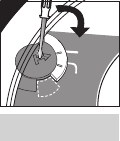
21
NOTE: Installing the alarm on the mounting bracket will automatically activate the battery backup if it
hasn’t already been activated.
B. Open the Kidde App and follow instructions on the App to finish Wi-Fi enrollment.
NOTE: If no further steps are taken within 15 minutes of initial power up, a voice prompt, “Not Connect-
ed” will be heard once, and the Wi-Fi function will turn off. The unit will then perform as a standard
hardwired alarm. See Section 11.3 for reactivating Wi-Fi features.
C. After the Wi-Fi enrollment is completed, the alarm will announce “Success, now connected.”
D. Repeat steps A through C with each alarm to be enrolled with Wi-Fi.
11.2 Adding Another Device to an Existing Wi-Fi Alarm Network
For various reasons, you might want to add additional units to your existing Wi-Fi alarm network. Modifying your
existing Wi-Fi alarm network is easy and user-friendly.
A. Follow wiring instructions and install the mounting bracket to prepare for
alarm installation (Section 9).
B. Activate the backup battery, apply AC power, install alarm.
• Locate the red wheel on the back of the device. Turn the red wheel to the
“ON” position on the device using a standard screwdriver. (Figure 11.2-B)
• Once the battery is activated, the device will emit a power on sound and blink green
once every two minutes.
• Connect the AC Quick Connector Harness. When AC power is connected,
the alarm will announce “Readyto connect, follow quick start instructions.”
• Install the alarm fully on the mounting bracket by rotating the alarm in a clockwise direction.
NOTE: The alarm will mount to the bracket in 4 positions (every 90 degrees).
NOTE: Installing the alarm on the mounting bracket will automatically activate the battery backup if it
hasn’t already been activated.
C. Open the Kidde App and follow instructions on the App to finish Wi-Fi enrollment.
NOTE: If no further steps are taken within 15 minutes of initial power up, a voice prompt, ““Not Connected” will
be heard once, and the Wi-Fi function will turn off. The unit will then perform as a standard hardwired alarm. See
Section 11.3 for reactivating Wi-Fi features.
D. After the Wi-Fi enrollment is completed, the alarm will announce “Success, now connected.”
E. Repeat steps A through D with each alarm to be enrolled with Wi-Fi.
ON
PERMANENTLY
DISABLE and
DISCHARGE
alarm
Break
tab
SMOKE ALARM: 3 long beeps, repeating
CO ALARM: 4 quick beeps, repeating
STANDBY: Green LED blink every 60s
FAULT: Amber LED blink with chirp every 30s
LOW BATTERY: Amber LED blink every 5s, chirp every 60s
END OF UNIT LIFE: Amber LED blink every 5s, chirp twice every 30s
Push button to test weekly.
See user guide for more information
Figure 11.2- B

22
11.3 Resetting a Device’s Wireless Settings
If you encounter an issue at any point during the Wi-Fi enrollment process, you may reset the device by following the
directions below.
A. Begin reset
• Press and hold the button on the device for 8-9 seconds until you hear 3
beeps. Release button. You will hear the words “Resetting wireless settings.”
B. Conclude reset
Light ring will flash green once and then it will pulse red. You will hear the
words, “Ready to connect, follow quick start instructions.”
• Device has been reset.
• See Section 11.1 to begin Wi-Fi enrollment, or Section 11.2 for adding this
device to an existing Wi-Fi alarm network.
NOTE: If no further steps are taken within 15 minutes of resetting the unit’s wireless settings, a voice
prompt “Not Connected” will be heard once, and the Wi-Fi function will turn off. The unit will then
perform as a standard hardwired alarm. See Section 11.2 for adding this device to an existing alarm
network.
11.4 Amazon Alexa and Google Assistant
TM
Your WiFi alarm is compatible with Amazon Alexa and Google Assistant. Follow instructions in the
Kidde app help section to link your WiFi alarm to Amazon Alexa and/or Google Assistant.*
* AMAZON and ALEXA are trademarks of Amazon Technologies, Inc. or its affiliates.
Google and Google Assistant are trademarks of Google LLC.
“Ready to
connect, follow
Quick Start
instructions.”
Figure 11.3-B
Figure 11.3-A
Hold for
8-9 seconds
“Resetting
wireless
settings.”

23
CO ALARM SENSOR RESPONSE TIMES
At 70 PPM, the unit must alarm within 60-240 minutes.
At 150 PPM, the unit must alarm within 10-50 minutes.
At 400 PPM, the unit must alarm within 4-15 minutes.
POSSIBLE CHIRPING REASONS
End of Unit Life: will be suppressed at night
Network Error: will be suppressed at night
Low battery: will be suppressed at night
12. Operation and Testing
Operation
The alarm is operating once it is activated and testing is
complete. When products of combustion (smoke or CO) are
sensed, the unit sounds a loud alarm with voice messages. (See
Sections 1 and 2 for alarm signal descriptions). In high levels of
CO, the unit will go into alarm in a shorter period of time than
at low levels of CO.
Testing
Test your alarm weekly by pressing and releasing the button quickly. A quick beep will confirm the button has been
pushed followed by voice prompts that will inform you of the upcoming test sequence. See Other Alarm Visual and
Audible Indicators table. The alarm and voice (and any interconnected units) will sound if the electronic circuitry,
horn, speaker, and battery are working. If the alarm test sequence does not sound, it is possible that the Wi-Fi
connection has been lost. See Troubleshooting Guide and check your Wi-Fi connection. If the Wi-Fi connection is
stable, and if the alarm or voice does not sound, or gives erratic or low volume sound, the unit must be replaced. See
Permanently Disable Alarm / Discharge Battery section to determine how to prepare the unit for shipment or disposal.
NOTE: If you push the test button on your alarm, the app will send you a text message. However, if you conduct a
remote test using the app, you will not receive a text message.
WARNING: DUE TO THE LOUDNESS OF THE ALARM, ALWAYS STAND ABOUT 2.5 FEET AWAY
FROM THE UNIT OR USE EAR PROTECTION WHEN TESTING.
WARNING: DO NOT USE AN OPEN FLAME TO TEST YOUR ALARM, YOU COULD DAMAGE THE
ALARM OR IGNITE COMBUSTIBLE MATERIALS AND START A STRUCTURE FIRE.
Ambient Light Sensing
In low light ambient conditions, the green LED ring fades to off, and then
blinks approx every 60 seconds.
This unit samples the ambient light conditions of the alarm’s location
and, if possible, determines a Night / Day cycle. A valid Night / Day cycle
will delay unit chirps during the night until the next Day cycle begins.
Chirping
When chirping begins during the next Day cycle, you can temporarily silence End of Unit Life or Network Error chirps
by pressing the button. Low Battery chirps cannot be silenced.
If a valid Night / Day cycle has not been established because the unit is located in either a constantly dark or lighted
location, the chirps mentioned above will not be delayed at night. Moving the unit to a different location might allow
the unit to determine a valid Night / Day cycle.
WARNING: REPLACE UNIT AS SOON AS POSSIBLE WHEN IN END OF UNIT LIFE OR LOW BATTERY MODE.

24
13. Recognizing Nuisance Alarms
Smoke Nuisance
HUSH®: If you know why the alarm is sounding, and you can verify that it is not a life threatening situation, you can
push the button on the initiating unit (green LED flashing every second) to silence the alarm for 8-10 minutes. If the
smoke is not too dense, that unit, and all interconnected units will silence. After the Hush® period, the smoke alarm will
automatically reset and sound the alarm if particles of combustion are still present. You can use Hush® repeatedly until
the air has been cleared of the condition causing the alarm.
NOTE: Dense smoke will override Hush® and sound a continuous alarm. If no fire is present, check to see
if one of the reasons listed in “Locations to avoid” may have caused the alarm. If a fire is discovered, get
out and call the fire department or 911.
This alarm is designed to minimize nuisance alarms. Cigarette smoke will not normally cause the unit to alarm, unless
the smoke is blown directly into the alarm. Combustion particles from cooking may set off the alarm if it is located too
close to a cooking appliance. Large quantities of combustible particles are generated from spills or when broiling. Using
the fan on a range hood which vents to the outside (non-recirculating type) will also help prevent nuisance alarms from
occurring by removing these combustible products from the kitchen.
Carbon Monoxide (CO) Nuisance
RESET: Pushing the button during CO alarm allows the unit to reset calculations and double check for the presence of
CO. If the unit re-alarms within 6 minutes, it is sensing high levels of CO which can quickly become a dangerous situa-
tion. Move to fresh air and call 911.
WARNING: IT IS IMPOSSIBLE TO DETERMINE THE SOURCE OF A CO ALARM USING SIGHT OR SMELL.
ALWAYS CONSIDER A CO ALARM EVENT AS DANGEROUS.

25
14. Battery Backup
This alarm is powered with AC power, but also contains a sealed lithium battery backup system. No battery installation
or replacement is necessary for the life of the alarm.
NOTE: AC power must be connected to obtain the full 10 year battery and unit life. Constant exposure to
high or low humidity or temperatures may reduce battery life.
NOTE: If AC power is lost, Wi-Fi features will not function, but the backup battery will still provide smoke and
CO detection.
WARNING: NO SERVICEABLE PARTS INCLUDED. DO NOT ATTEMPT TO OPEN THE ALARM FOR ANY
REASON! DO NOT TRY TO REPAIR THE ALARM YOURSELF.
Low Battery
This alarm is equipped with a low battery monitor circuit. If the battery capacity is nearing the point where it can no
longer provide adequate power for all alarm functions, the low battery condition will occur. See Troubleshooting Guide.
The unit must be replaced within 7 days of the first occurrence of the “Low Battery Warning” to provide continuous
alarm detection.
CAUTION: THE BATTERY USED IN THIS DEVICE MAY PRESENT A FIRE OR CHEMICAL BURN HAZARD IF
MISTREATED. DO NOT RECHARGE, DISASSEMBLE, HEAT ABOVE 100°C (212°F) OR DISPOSE OF IN FIRE.
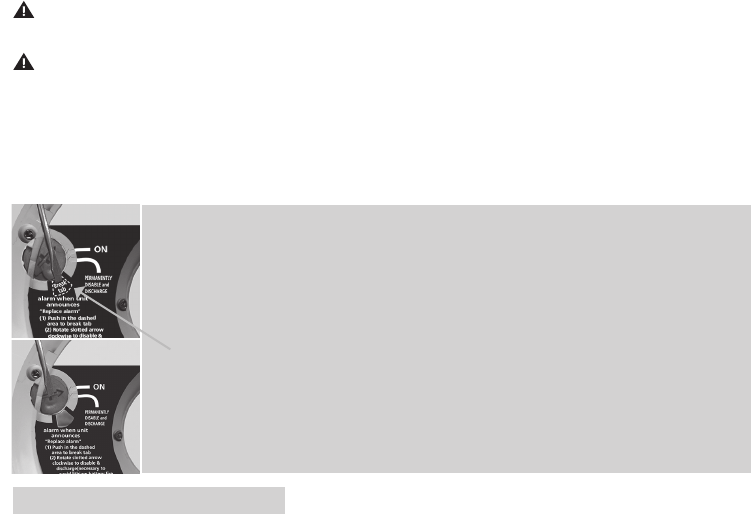
26
15. Permanently Disable Alarm / Discharge Battery
WARNING: FAILURE TO DISCHARGE ALARM BATTERY AS INSTRUCTED PRIOR TO
DISPOSAL MAY CREATE POTENTIAL FOR LITHIUM BATTERY RELATED FIRE OR HAZARD.
WARNING: DISCHARGING THE ALARM BATTERY IS PERMANENT
• Once the alarm battery has been discharged, it cannot be reactivated!
• Once discharged, the alarm will NO LONGER DETECT SMOKE OR CO.
• Once the alarm battery is discharged, the battery is depleted and the alarm will no longer function.
• Once the alarm battery has been discharged, the alarm cannot be mounted onto the mounting plate or reactivated.
To Permanently Disable Alarm / Discharge Battery:
• Rotate the alarm counterclockwise to remove it from the mount-
ing plate.
• Disconnect AC wiring harness.
• Push in the dashed area with a screwdriver to break tab.
• After the tab is broken, use the screwdriver to turn the red slot-
ted arrow to the "Permanently Disable Alarm / Discharge Battery"
location. This will disable the alarm, stop the low battery or end
of unit life “chirps” and render the alarm safe for disposal by
draining the battery.
Figures 15-A (top) and 15-B(bottom)
27
16. General Carbon Monoxide (CO) Information
Carbon monoxide (CO) is a colorless, odorless, and tasteless poison gas that can be fatal when inhaled. CO inhibits the
blood’s capacity to carry oxygen.
Possible Sources of CO
Inside your home, appliances used for heating and cooking are the most likely sources of CO. Vehicles running in
attached garages can also produce dangerous levels of CO. CO can be produced when burning any fossil fuel: gasoline,
diesel, propane, natural gas, oil and wood. It can be produced by any fuel-burning appliance that is malfunctioning,
improperly installed, or not ventilated correctly, such as: Furnaces/boilers, gas ranges/stoves, gas clothes dryers, water
heaters, portable fuel burning space heaters, fireplaces, wood-burning stoves and certain swimming pool heaters.
Blocked chimneys or flues, back drafting and changes in air pressure, corroded or disconnected vent pipes, or a loose or
cracked furnace heat exchanger can also release CO into your building. Vehicles and other combustion engines running
in an attached garage and using a charcoal/gas grill or hibachi in an enclosed area are all possible sources of CO.
The following conditions can result in transient CO situations:
Excessive spillage or reverse venting of fuel-burning appliances caused by outdoor ambient conditions such as: Wind
direction and/or velocity, including high gusts of wind, heavy air in the vent pipes (cold/humid air with extended periods
between cycles), negative pressure differential resulting from the use of exhaust fans, simultaneous operation of several
fuel-burning appliances competing for limited internal air, vent pipe connections vibrating loose from clothes dryers,
furnaces/boilers, or water heaters, obstructions in, or unconventional, vent pipe designs which can amplify the above
situations, extended operation of unvented fuel-burning devices (range, oven, fireplace, etc.), temperature inversions
which can trap exhaust gases near the ground, car idling in an open or closed attached garage, or near a home.
28
CO Safety Tips
Every year, have the heating system, vents, chimney and flue inspected and cleaned by a qualified technician. Always
install appliances according to manufacturer’s instructions and adhere to local building codes. Most appliances should be
installed by professionals and inspected after installation. Regularly examine vents and chimneys for improper connec-
tions, visible rust, or stains, and check for cracks in furnace heat exchangers. Verify that the color of flame is blue on pilot
lights and burners. An amber or orange flame is a sign that the fuel is not burning completely and may be releasing CO.
Teach all household members what the alarm sounds like and how to respond. Fire Departments, most utility companies
and HVAC contractors will perform CO inspections. Some contractors may charge for this service. It’s advisable to inquire
about any applicable fees prior to having the service performed. Kidde will not pay for, or reimburse the owner or user of
this product, for any repair or dispatch calls related to the alarm sounding.
Symptoms of CO Poisoning
Initial carbon monoxide poisoning symptoms are similar to the flu with no fever and can include dizziness, severe
headaches, nausea, vomiting and disorientation. Everyone is susceptible but experts agree that unborn babies, pregnant
women, senior citizens and people with heart or respiratory problems are especially vulnerable. If symptoms of carbon
monoxide poisoning are experienced seek medical attention immediately. CO poisoning can be determined by a carboxy-
hemoglobin test.
The following symptoms are related to CARBON MONOXIDE POISONING and should be discussed with
ALL members of the household:
1. MILD EXPOSURE: Slight headache, nausea, vomiting, fatigue (often described as “Flu-like” symptoms).
2. MEDIUM EXPOSURE: Severe throbbing headache, drowsiness, confusion, fast heart rate.
3. EXTREME EXPOSURE: Unconsciousness, convulsions, cardio respiratory failure and death.
The above levels of exposure relate to healthy adults. Levels differ for those at high risk. Exposure to high levels of carbon
monoxide can be fatal or cause permanent damage and disabilities. Many cases of reported carbon monoxide poisoning
indicate that while victims are aware they are not feeling well, they become so disoriented they are unable to save them-
selves by either exiting the building, or calling for assistance. Also, young children and household pets may be the first
affected. Familiarization with the effects of each CO exposure level is important.

29
17. Cleaning Your Alarm
Your Alarm Should be Cleaned at Least Once a Year
You can clean the interior of your alarm (sensing chamber) by using compressed air or a vacuum cleaner hose and blow-
ing or vacuuming through the openings around the perimeter of the alarm. The outside of the alarm can be wiped with
a damp cloth. Use only water to dampen the cloth, use of detergents or cleaners could damage the alarm.
If the alarm is in Fault mode and the Red LED is blinking a fault code of 10 or 14 flashes (after a button push), the alarm
may be in need of cleaning. After cleaning, press the button. If the fault does not clear, the alarm needs to be replaced.
• Never use detergent or other solvents to clean the unit.
• Avoid spraying air freshener, hair spray, or other aerosols near the alarm.
• Do not paint the unit. Paint will seal the vents and interfere with the sensor’s ability to detect smoke and CO.
• Never attempt to disassemble the unit to clean inside. This action will void your warranty.
• The following substances can affect the CO sensor and may cause false readings and damage to the sensor: Meth-
ane, propane, isobutane, iso-propanol, ethyl acetate, hydrogen sulfide, sulfide dioxides, alcohol based products,
paints, thinner, solvents, adhesives, hair spray, aftershave, perfume, and some cleaning agents.
• Move the Alarm and place in another location prior to performing any of the following:
Staining or stripping wood floors or furniture
Painting
Wall papering
Using adhesives
Storing the unit in a plastic bag during any of the above projects will protect the sensors from damage. When household
cleaning supplies or similar contaminates are used, the area must be well ventilated.
WARNING: REINSTALL THE ALARM AS SOON AS POSSIBLE TO ENSURE CONTINUOUS DETECTION.
30
18. Good Safety Habits
Develop and Practice a Plan of Escape
Prepare and practice a home escape plan twice a year, including drills at night. Know two ways out of every room (door
& window) and identify a meeting place outside the home where everyone will gather once they have exited the resi-
dence. When two people have reached the meeting place, one should leave to call 911 while the second person stays to
account for additional family members. Establish a rule that once you’re out, you never re-enter under any circumstance!
• Make a floor plan indicating all doors and windows and at least two (2) escape routes from each room. Second story
windows may need a rope or chain ladder.
• Have a family meeting and discuss your escape plan, showing everyone what to do in case of fire and where to meet
after they leave the house.
• Ensure that small children hear the alarm and wake when it sounds. They must wake up in order to execute the
escape plan. Practice allows all occupants to test your plan before an emergency. You may not be able to reach your
children. It is important they know what to do.
• Familiarize everyone with the sounds of the smoke/CO alarm and train them to leave your home when they hear it.
• Current studies have shown smoke/CO alarms may not awaken all sleeping individuals, and that it is the responsibili-
ty of individuals in the household that are capable of assisting others to provide assistance to those who may not be
awakened by the alarm sound, or to those who may be incapable of safely evacuating the area unassisted.
• Install and maintain fire extinguishers on every level of the home and in the kitchen, basement and garage. Know
how to use a fire extinguisher prior to an emergency.
Fire Prevention
Never smoke in bed, or leave cooking food unattended. Teach children never to play with matches or lighters! Train ev-
eryone in the home to recognize the smoke alarm pattern and to leave the home using their escape plan when it’s heard.
Know how to do “Stop, Drop and Roll” if clothes catch on fire, and how to crawl low under smoke. Install and maintain
fire extinguishers on every level of the home and in the kitchen, basement and garage.
NFPA (National Fire Protection Association)
Fire Safety in the Home: NFPA 72 is intended to provide reasonable safety for persons in family living units. Reason-
able fire safety can be produced through the following three-point program: (1) Minimizing fire hazards (2) Providing
fire-warning equipment (3) Having and practicing an escape plan.

31
Smoke Detection – Are More Alarms Desirable?
The required number of smoke alarms might not
provide reliable early warning protection for those
areas separated by a door from the areas protected by
the required smoke alarms. For this reason, it is recom-
mended that the resident consider the use of additional
smoke alarms for those areas for increased protection.
The additional areas include the basement, bedrooms,
dining room, furnace room, utility room, and hallways not
protected by the required smoke alarms. The installation of
smoke alarms in attics (finished or unfinished), garages, or
within 6’ of a heating or cooking appliance is not normally
recommended, as these locations occasionally experience
conditions that can result in improper operation. *
California State Fire Marshal
Early warning fire detection is best achieved by the installation of fire detection equipment in all rooms and areas of the
household as follows: A smoke alarm installed in each separate sleeping area (in the vicinity, but outside the bedrooms),
heat or smoke detectors in the living rooms, dining rooms, bedrooms, kitchens, hallways, attics, furnace rooms, closets,
utility and storage rooms, basements and attached garages.
* Reference National Fire Protection Association (NFPA) standard 72
For your information, the National Fire Protection
Association’s Standard 72 reads: Where required
by other governing laws, codes, or standards for
a specific type of occupancy, approved single and
multiple-station smoke alarms shall be installed as
follows:
1. In all sleeping rooms and guest rooms
2. Outside of each separate dwelling unit sleeping
area, within 21 ft (6.4 m) of any door to a sleep-
ing room, with the distance measured along a
path of travel
3. On every level of a dwelling unit, including
basements
4. On every level of a residential board and care oc-
cupancy (small facility), including basements and
excluding crawl spaces and unfinished attics
5. In the living area(s) of a guest suite
6. In the living area(s) of a residential board and care
occupancy (small facility)

32
FCC (Contains FCC ID: 2AC7Z-ESPWROOM32UE)
This equipment has been tested and found to comply with the limits for a Class B digital device, pursuant to part 15 of
the FCC Rules. These limits are designed to provide reasonable protection against harmful interference in a residential
installation. This equipment generates, uses and can radiate radio frequency energy and, if not installed and used in
accordance with the instructions, may cause harmful interference to radio communications. However, there is no
guarantee that interference will not occur in a particular installation. If this equipment does cause harmful interference
to radio or television reception, the user is encouraged to try to correct the interference by one or more of the following
measures:
• Reorient or relocate the receiving antenna.
• Increase the separation between the equipment and receiver.
• Connect the equipment into an outlet on a circuit different from that to which the receiver is connected.
• Consult the dealer or an experienced radio/TV technician for help.
WARNING! ANY CHANGES OR MODIFICATION MADE TO THE PRODUCT WITHOUT THE PERMISSION
OF THE MANUFACTURER COULD VOID THE USER’S AUTHORITY TO USE THIS PRODUCT.
This device complies with part 15 of the FCC Rules. Operation is subject to the following two conditions: (1) This device
may not cause harmful interference, and (2) this device must accept any interference received, including interference that
may cause undesired operation.
33
19. Service and Warranty
Ten-Year Limited Warranty
Kidde warrants that the enclosed alarm will be free from defects in material and workmanship or design under normal
use and service for a period of ten years from the date of purchase. The obligation of Kidde under this warranty is
limited to repairing or replacing the alarm or any part which we find to be defective in material, workmanship or design
(part replacement only, no installation), free of charge, upon receiving the alarm with proof of date of purchase, postage
and return postage prepaid, to Warranty Service Department, Kidde, 1016 Corporate Park Drive, Mebane, NC 27302.
Before shipping the product, follow the steps in the Permanently Disable Alarm / Discharge Battery section.
This warranty shall not apply to the alarm if it has been damaged, modified, abused or altered after the date of purchase
or if it fails to operate due to improper maintenance or inadequate power. Any implied warranties arising out of this sale,
including but not limited to the implied warranties of description, merchantability and fitness for a particular purpose,
are limited in duration to the above warranty period. In no event shall the Manufacturer be liable for loss of use of this
product or for any indirect, special, incidental or consequential damages, or costs, or expenses incurred by the consumer
or any other user of this product, whether due to a breach of contract, negligence, strict liability in tort or otherwise.
The Manufacturer shall have no liability for any personal injury, property damage or any special, incidental, contingent
or consequential damage of any kind resulting from gas leakage, smoke, fire or explosion. Since some states do not
allow limitations of the duration of an implied warranty or do not allow the exclusion or limitation of incidental or
consequential damages, the above limitations or exclusions may not apply to you. While this warranty gives you specific
legal rights, you may also have other rights which vary from state to state.
The above warranty may not be altered except in writing signed by both parties hereto. Your Kidde Alarm is not a
substitute for property, fire, disability, life or other insurance of any kind. Appropriate insurance coverage is your
responsibility. Consult your insurance agent. Opening the unit will void the warranty.
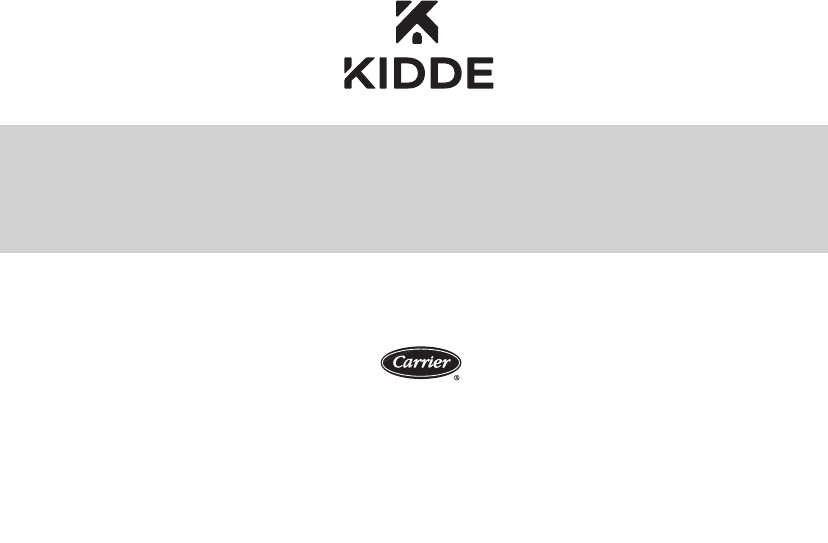
34
QUESTIONS OR FOR MORE INFORMATION
Call Kidde Product Support line at 1-877-542-5471
or contact us at www.kidde.com
Kidde
1016 Corporate Park Drive, Mebane, NC 27302
Kidde’s General Privacy Notice can be found at:
https://www.corporate.carrier.com/legal/privacy-notice/
A Carrier Company
©2022 Carrier. All Rights Reserved.
™
